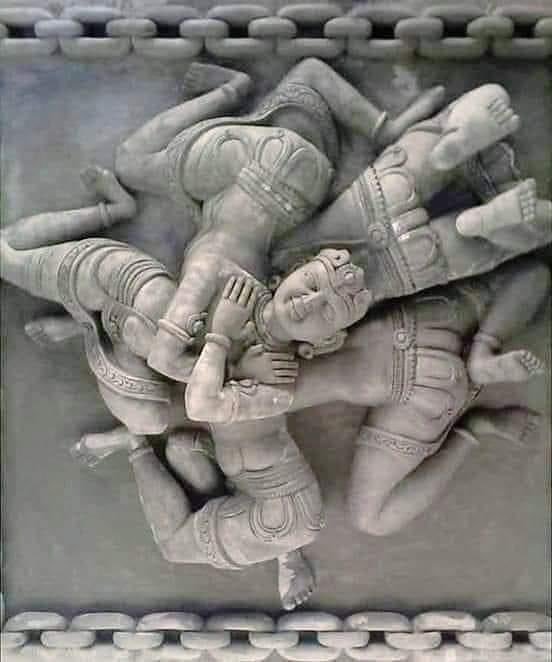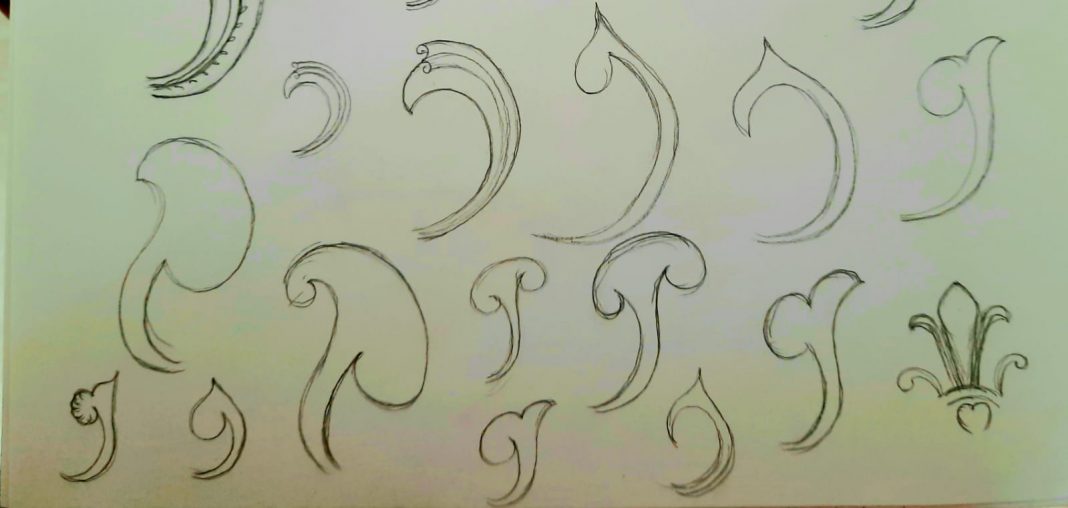Hindu Temple: Symbolism and Iconography. Part 3


Namaste, This is the part 3 of the series of Hindu Temples which covers the Introduction and touch upon the topics of Symbolism and Iconography. To read the earlier two kindly click part one and part two.
Shilpa Shastra is not a generic modern art. It is a tradition where art is intertwined with philosophy & each pattern has a meaning. Every symbol is a code to the vast knowledge that has evolved and refined over centuries decipherable after understanding the subject. Gigantic stone temples took decades & generations to build so clearly the creators, artists and sculptors did not create them for personal consumption. They were sculpted for society & inheritance for future generations.
Unlike the schools of realism where the present object is faithfully represented in form, the traditional Shilpa style requires the artist to respond inwardly to the stimulus and, from this send a response, create the image with all the artistic skills at his command. the formlessness is expressed in terms of body features signified Universal Rhythm and balance. Thus, the intangible takes a concrete and real form. the Shilpa text has, therefore, specified these forms and images as being suitable for worship.
The text also states that it is not appropriate to worship images fashion in the proportions of a human body, though they may be following the natural order. This is because the human body is subject to change and end in time. But, the image produced by the application of the grammar set out in the mana lakshanam [ iconometry ] is eternal, and, hence, untouched by time. in the sculptural tradition, grammar is very important and is considered to be the process through which the Brahman manifests itself. It is thus of vital importance that the sculptors in the traditional style should fully comprehend the grammar and order of this system. Only will then they be able to design with utmost clarity.
‘In ancient period during non-war times, the soldiers of a kingdom were also employed in the temple construction to keep them occupied and they also contributed in inputs from their visits to different lands during war times’. Sculptor G. L. Bhat. (Bangalore).
Whether an images is created for worship or as an object of art, the sculptor should have a thorough knowledge of the following:
Classification of images
There are three broad classifications of images
Chitram- sculpture in the round.
Chitrardham- sculpture in bold relief (i.e sculptures that have frontal part carved in full detail and rare pare portion is flat. Carvings on face of stone.)
Chitrabhasham- representation on a plane surface (painting).


Temple Architecture and measurements with which a temple is constructed and Deities are sculpted is a separate in-dept study. Talamana is unit of measure in Shilpa Shastra used for sculpting Bhagwan, Devata, Yaksha, Humans, Animals. Each category follows its own specification and rules to creating respective images. People who are interested in this area can read works of people mentioned in credits. Life is a pilgrimage from birth to death has many stations. In Sanatan Dharma, death is but another station and in itself does not bring final release [ Moksha ]. Final release from all limitations is gained through knowledge. Knowledge, the realization of Supreme identity, is the means of an end itself. Some attain while alive and others at death. while for those who are without the faculties and training to make them fit for the realization of the supreme knowledge, other paths lie open which also lead to the Centre.
Pilgrimage is an open path amongst many which bring joy and bhakti. Tirtha is the name of a place of pilgrimage on the bank of a river, seashore, or lake. A pilgrim who crosses the current of a river which represents his life journey reaching the other shore is means to end, it’s a journey.- Stella Kramrisch. This concept is characterized in Temple planning.

The term ICON means a figure representing a deity, or a saint, in painting, mosaic, sculpture, etc., which is specially meant for worship or which is in some way or other associated with the ritual connected with the worship of different divinities. The special branch of knowledge or study which deals with these images is generally known as Iconography. It is governed by rules and regulations, attributes and measurements of a theme are clearly defined. A Hindu icon is not the casual reproduction of a form, as done in modern abstract art, that an artist could conceive, design, and bring forth as led by his fantasy. Unless warranted by religious and philosophical needs, the theoretical framework of an iconographical form could not be altered by the artist.
Indian iconography is the fruit of the religious view of life in India and is the main fulcrum around which all the cultural aspects rotate. The form under which the Hindu religion appears is taught in the Vedas. The primary character of the rituals of Vedas is the worship of the personified elements of Agni, Vayu, the air, the water, the sun; som, the moon; and other elementary and planetary personages.
The objects worshipped by Hindus are images, of gods and goddesses, Salagramas, Bana-Lingas, Yantras (Shri yantra, etc.) certain animals, reptiles and birds (Lion, Bull, Cow, Horse, Eagle, peacock, Snake, etc.), certain holy rivers (Ganga, Yamuna, Krishna, Kaveri, Narmada, Sarasvati, etc.), tanks, trees (Basil, Banyan, Ficus religiosa, etc.) and sculptures of saints. Besides these, there are several objects of local importance and personal predilection, which are also used as objects of worship.

Terms of Image
In Sanskrit there is a very rich terminology that is used when referring to icons; Bera — image, Mūrtī — anything which has a definite shape and physical limits, Bimba — reflection or prototype — the original or model after which a thing is copied (the Original Being, of course, is God), Vigraha — extension, expansion, form. Pratima — resemblance, similitude, representation, Pratīka — symbol, Rūpa — form, aggregate, a total of form. Arca — an object of adoration and worship.
Symbolism
Everything connected with the Hindu icon has a symbolic meaning; the posture, gestures, ornaments, number of arms, weapons, vehicle, consorts, and associate deities. Symbolic meanings of various rituals and paraphernalia are first given in the Brāhmanas and Aranyakas, and later the iconic symbols are explained in the various Purāṇas and Āgamas. Iconology is defined as the study of the symbolism behind sacred images. One of the most prominent tools of devotion in Hinduism is the use of images. The language of symbols develops when an attempt is made to represent something that is beyond the normal capacity of the human mind to comprehend or to express. A transcendent reality is expressed in terms of equivalents known as symbols. All human interaction is carried out through the use of symbols. A symbol can be natural or conventional. When we perceive a direct relationship between one order of things with another a natural symbol develops. In Hindu cosmology, symbolism is the expression of reality. It is the expression of the particular points where two realms meet — the transcendental (niṣkala) with the material (Sakala). The whole of Indian iconology is built up upon a code of symbols based on the assumption that there exists a natural affinity between ideas (nāma) and forms (rūpa). Symbols do not speak to the rational mind and cannot be fully understood by logic, they are the subject of contemplation, worship, assimilation, inner experience, and ultimate spiritual realization. Symbols are the esoteric language of the unconscious mind. A flower is the symbol of purity, happiness, the sweet fragrance that is enchanting is used in sculpting to enhance the beauty of an object created. It is the perception of the mind that the Shilpi translates through his art and sadhana into poetry that we read on the walls of temples. The language of art has its vocabulary, grammar & rules. Every symbol has its own Gunadharma (quality). Iconography and symbolism tell us how to understand the meaning of a Deity, the weapon or object it’s holding, the pose it holds, the hand gesture has a purpose, the ornamentation or lack of it has meaning. Once we understand that, we will be able to appreciate the grandeur and beauty of Temples. Iconography is a vast subject, for further understanding kindly refer the authors in credits.
Credits: I would like to thank a long list of people whose work has helped, inspired, and I learned a lot to write this piece. V. Ganapathy Sthapati, Stella Kramrisch, Jitendra Nath Banerjea, T.A. Gopinath, Talks by Shashikala at its.iitgn.ac.in, Harish Johari, Sahana Singh, Talk by Sinu Joseph, Rare books by multiple authors on Indian Temple and architecture, Iconography and Symbolism from the site https://indianculture.gov.in/. Special Thanks to Vibhu Academy, team, and Guruji G. L Bhat and Arthi.

DISCLAIMER: The author is solely responsible for the views expressed in this article. The author carries the responsibility for citing and/or licensing of images utilized within the text.
